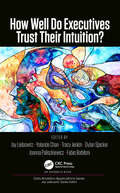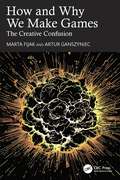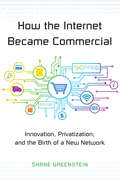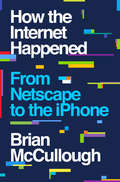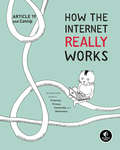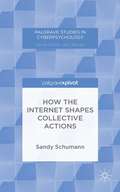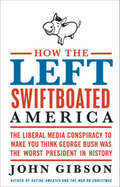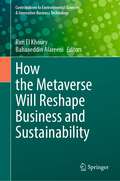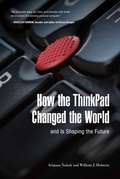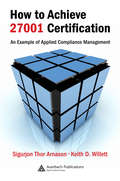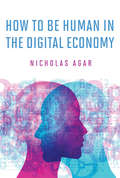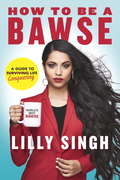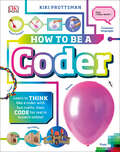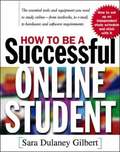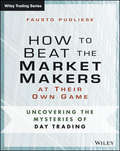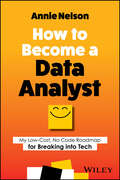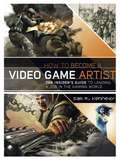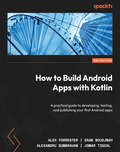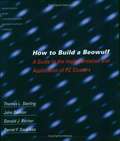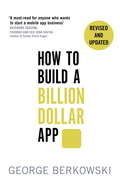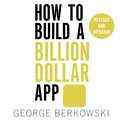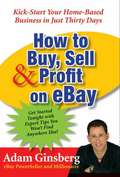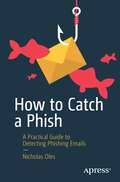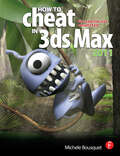- Table View
- List View
How Well Do Executives Trust Their Intuition (Data Analytics Applications)
by Yolande Chan Fabio Babiloni Joanna Paliszkiewicz Jay Liebowitz Tracy Jenkin Dylan SpickerIn this age of Big Data and analytics, knowledge gained through experiential learning and intuition may be taking a back seat to analytics. However, the use of intuition should not be underestimated and should play an important role in the decision process. <P><P>How Well Do Executives Trust Their Intuition covers the Fulbright research study conducted by this international team of editors. The main question of their investigation is: How well do executives trust their intuition? In other words, do they typically prefer intuition over analysis and analytics. And equally importantly, what types of intuition may be most favorable looking at different variables? The research utilizes survey and biometrics approaches with C-level executives from Canada, U.S., Poland, and Italy. <P><P>In addition, the book contains chapters from leading executives in industry, academia, and government. Their insights provide examples of how their intuition enabled key decisions that they made. <P><P>This book covers such topics as: <li>Using intuition <li>How gender, experience, role, industry, and country affect intuition <li>Trust and intuition in management <li>Trusting intuition <li>It’s a matter of heart <li>Leadership intuition and the future of work <li>Creating an intuitive awareness for executives <li>Improvisation and instinct. <P><P>The book explores how executives can use intuition to guide decision making. It also explains how to trust intuition-based decisions. How Well Do Executives Trust Their Intuition is a timely and prescient reminder in this age of data-driven analytics that human insight, instinct, and intuition should also play key roles.
How and Why We Make Games: The Creative Confusion
by Marta Fijak Artur GanszyniecThis book delves into the intricate realms of games and their creation, examining them through cultural, systemic, and, most notably, human lenses. It explores diverse themes such as authorship, creative responsibility, the tension between games as a product and games as a form of cultural expression, and the myth of a universal audience.The book analyzes why we should put politics in our games and how hyperrealism may be a trap. It also proposes a new framework for thinking about game narrative and a different paradigm for the production altogether. Topics tackled are approached from a multidisciplinary perspective, so be prepared to read both about Peter Paul Rubens and John Carmack. There are also graphs, system rhetorics discussions, and the market reality—stakeholders, return on investments, and the gaming bubble bursting.This book is written for readers passionate about the craft of making games, including journalists and industry professionals. It offers a more humanistic perspective on games, presented by experienced writers who know the intricacies of game development.
How the Internet Became Commercial
by Shane GreensteinIn less than a decade, the Internet went from being a series of loosely connected networks used by universities and the military to the powerful commercial engine it is today. This book describes how many of the key innovations that made this possible came from entrepreneurs and iconoclasts who were outside the mainstream--and how the commercialization of the Internet was by no means a foregone conclusion at its outset.Shane Greenstein traces the evolution of the Internet from government ownership to privatization to the commercial Internet we know today. This is a story of innovation from the edges. Greenstein shows how mainstream service providers that had traditionally been leaders in the old-market economy became threatened by innovations from industry outsiders who saw economic opportunities where others didn't--and how these mainstream firms had no choice but to innovate themselves. New models were tried: some succeeded, some failed. Commercial markets turned innovations into valuable products and services as the Internet evolved in those markets. New business processes had to be created from scratch as a network originally intended for research and military defense had to deal with network interconnectivity, the needs of commercial users, and a host of challenges with implementing innovative new services.How the Internet Became Commercial demonstrates how, without any central authority, a unique and vibrant interplay between government and private industry transformed the Internet.
How the Internet Happened: From Netscape To The Iphone
by Brian McCulloughTech-guru Brian McCullough delivers a rollicking history of the internet, why it exploded, and how it changed everything. The internet was never intended for you, opines Brian McCullough in this lively narrative of an era that utterly transformed everything we thought we knew about technology. In How the Internet Happened, he chronicles the whole fascinating story for the first time, beginning in a dusty Illinois basement in 1993, when a group of college kids set off a once-in-an-epoch revolution with what would become the first “dotcom.” Depicting the lives of now-famous innovators like Netscape’s Marc Andreessen and Facebook’s Mark Zuckerberg, McCullough also reveals surprising quirks and unknown tales as he tracks both the technology and the culture around the internet’s rise. Cinematic in detail and unprecedented in scope, the result both enlightens and informs as it draws back the curtain on the new rhythm of disruption and innovation the internet fostered, and helps to redefine an era that changed every part of our lives.
How the Internet Really Works: An Illustrated Guide to Protocols, Privacy, Censorship, and Governance
by Article 19An accessible, comic book-like, illustrated introduction to how the internet works under the hood, designed to give people a basic understanding of the technical aspects of the Internet that they need in order to advocate for digital rights.The internet has profoundly changed interpersonal communication, but most of us don't really understand how it works. What enables information to travel across the internet? Can we really be anonymous and private online? Who controls the internet, and why is that important? And... what's with all the cats?How the Internet Really Works answers these questions and more. Using clear language and whimsical illustrations, the authors translate highly technical topics into accessible, engaging prose that demystifies the world's most intricately linked computer network. Alongside a feline guide named Catnip, you'll learn about: • The "How-What-Why" of nodes, packets, and internet protocols • Cryptographic techniques to ensure the secrecy and integrity of your data • Censorship, ways to monitor it, and means for circumventing it • Cybernetics, algorithms, and how computers make decisions • Centralization of internet power, its impact on democracy, and how it hurts human rights • Internet governance, and ways to get involvedThis book is also a call to action, laying out a roadmap for using your newfound knowledge to influence the evolution of digitally inclusive, rights-respecting internet laws and policies.Whether you're a citizen concerned about staying safe online, a civil servant seeking to address censorship, an advocate addressing worldwide freedom of expression issues, or simply someone with a cat-like curiosity about network infrastructure, you will be delighted -- and enlightened -- by Catnip's felicitously fun guide to understanding how the internet really works!
How the Internet Shapes Collective Actions
by Sandy SchumannAfter a Facebook rebellion in Egypt and Twitter protests in Turkey, the internet has been proclaimed as a globe-shifting, revolutionizing force that can incite complex social phenomena such as collective actions. This book critically assesses this claim and highlights how internet use can shape mobilizing processes to foster collective actions.
How the Left Swiftboated America: The Liberal Media Conspiracy to Make You Think George Bush Was the Worst President in History
by John GibsonIn How the Left Swiftboated America, FOX commentator and bestselling author John Gibson offers the first comprehensive defense of the Bush presidency against its numerous detractors. In this provocative political work, Gibson explores who was right and who was wrong in taking us into the Iraq War and a host of other issues, arguing that it was the Left that actually lied while claiming to expose the truth.
How the Metaverse Will Reshape Business and Sustainability (Contributions to Environmental Sciences & Innovative Business Technology)
by Bahaaeddin Alareeni Rim El KhourySustainability is part of every aspect of our life, with climate concerns shaping the future. Thus, it is important to understand how metaverse will affect sustainability, as it is opening both challenges and opportunities for environmental sustainability. On the one side, replacing real-world interactions with 3D virtual and exchanging physical goods with digital ones are significantly less resource-intensive and more carbon-efficient. Therefore, this holds the promise of reducing the environmental pollution. On the other side, metaverse increases e-waste and energy consumption. Given this controversial impact, it is crucial for businesses and researchers to understand how to ensure that the metaverse develops sustainably. This book is popping out several questions: Do businesses understand the metaverse concept and perceive the benefits and advantages of implementing such technologies? How will the metaverse change business? Will metaverse change our working place and skills needed? How can companies get ahead of the change and mold it to their advantage? Will businesses use metaverse? Can metaverse create a more sustainable word? How can we make the metaverse better than what we have now? Is it going to affect environmental sustainability? Will it cause more severe climate problems, or would it be the solution? How can metaverse impact the achievements of SDGs?
How the ThinkPad Changed the World—and Is Shaping the Future
by William Holstein Arimasa NaitohThe ThinkPad notebook computer has been at the center of the digital revolution that has transformed millions of lives around the world, allowing users to obtain access to their documents, pictures and other personal data from virtually anywhere at any time. More than 100 million ThinkPads have been sold since they were introduced in 1992, some twenty-five years ago. ThinkPads played a prominent role in NASA's space exploration and at the International Space Station. They accompanied explorers who traversed the entire length of the Nile River and conquered Mount Everest. ThinkPads also played a major role in changing the very architecture of how humanity's knowledge is stored and made available.In this book, Arimasa Naitoh, the father of the ThinkPad, collaborates with American business journalist and author William J. Holstein to write candidly about the incredible technological and personal struggles he and fellow engineers faced. And he offers his vision of the future of mobile computing—because this revolution is not even close to being finished.
How to Achieve 27001 Certification: An Example of Applied Compliance Management
by Keith D. Willett Sigurjon Thor ArnasonThe security criteria of the International Standards Organization (ISO) provides an excellent foundation for identifying and addressing business risks through a disciplined security management process. Using security standards ISO 17799 and ISO 27001 as a basis, How to Achieve 27001 Certification: An Example of Applied Compliance Management helps a
How to Be Human in the Digital Economy (The\mit Press Ser.)
by Nicholas AgarAn argument in favor of finding a place for humans (and humanness) in the future digital economy.In the digital economy, accountants, baristas, and cashiers can be automated out of employment; so can surgeons, airline pilots, and cab drivers. Machines will be able to do these jobs more efficiently, accurately, and inexpensively. But, Nicholas Agar warns in this provocative book, these developments could result in a radically disempowered humanity.The digital revolution has brought us new gadgets and new things to do with them. The digital revolution also brings the digital economy, with machines capable of doing humans' jobs. Agar explains that developments in artificial intelligence enable computers to take over not just routine tasks but also the kind of “mind work” that previously relied on human intellect, and that this threatens human agency. The solution, Agar argues, is a hybrid social-digital economy. The key value of the digital economy is efficiency. The key value of the social economy is humanness.A social economy would be centered on connections between human minds. We should reject some digital automation because machines will always be poor substitutes for humans in roles that involve direct contact with other humans. A machine can count out pills and pour out coffee, but we want our nurses and baristas to have minds like ours. In a hybrid social-digital economy, people do the jobs for which feelings matter and machines take on data-intensive work. But humans will have to insist on their relevance in a digital age.
How to Be a Bawse: A Guide to Conquering Life
by Lilly SinghFrom the 2017 People’s Choice Award winner for Favorite YouTube Star comes the definitive guide to being a bawse: a person who exudes confidence, hustles relentlessly, and smiles genuinely because he or she has fought through it all and made it out the other side. Lilly Singh isn’t just a superstar. She’s Superwoman—which is also the name of her wildly popular YouTube channel. Funny, smart, and insightful, the actress and comedian covers topics ranging from relationships to career choices to everyday annoyances. It’s no wonder she’s garnered more than a billion views. But Lilly didn’t get to the top by being lucky—she had to work for it. Hard. Now Lilly wants to share the lessons she learned while taking the world by storm, and the tools she used to do it. How to Be a Bawse is the definitive guide to conquering life. Make no mistake, there are no shortcuts to success, personal or professional. World domination requires real effort, dedication, and determination. Just consider Lilly a personal trainer for your life—with fifty rules to get you in the game, including • Let Go of FOMO (Fear of Missing Out): Temptation will try to steer you away from your goals. FOMO is just a test of your priorities, a test that a bawse is ready to pass. • Be Nice to People: Treat niceness like an item on your daily to-do list. People will go out of their way to help and support you because you make them feel good. • Schedule Inspiration: Lack of motivation isn’t permanent or a sign of weakness. Expect it and proactively schedule time to be creative. • Be the Dumbest: Challenge yourself by surrounding yourself with people who know more than you do. It’s a vital way to learn and improve. Told in Lilly’s hilarious, bold voice and packed with photos and candid stories from her journey to the top, How to Be a Bawse will make you love your life and yourself—even more than you love Beyoncé. (Yes, we said it!) WARNING: This book does not include hopeful thoughts, lucky charms, or cute quotes. That’s because success, happiness, and everything else you want in life need to be worked for, not wished for. In Lilly’s world, there are no escalators, only stairs. Get ready to climb.Praise for How to Be a Bawse“Singh segues from her inspirational and uber-watched YouTube videos to essays on how to become a bawse, that is, a supremely self-confident person. She’s been named one of Time’s 2016 ‘30 Most Influential People on the Internet,’ Variety’s ‘10 Comics To Watch for 2016,’ Forbes’s ‘30 Under 30,’ Vogue’s ‘8 YouTube Stars That Are Taking Over the World,’ and more.”—Library Journal “Lilly is a bona fide #girlboss, boss, and bawse. Her meteoric rise has come with so many incredible lessons that we are all lucky to have access to. This book is a must-have for the hustler in all of us.”—Sophia Amoruso, founder and CEO, Girlboss
How to Be a Coder: Learn to Think like a Coder with Fun Activities, then Code in Scratch 3.0 Online (Careers for Kids)
by Kiki ProttsmanLearn to think like a coder without a computer! Each of the fun craft activities included in this book will teach you about a key concept of computer programming and can be done completely offline. Then you can put your skills into practice by trying out the simple programs provided in the online, child-friendly computer language Scratch.This crafty coding book breaks down the principles of coding into bite-sized chunks that will get you thinking like a computer scientist in no time. Learn about loops by making a friendship bracelet, find out about programming by planning a scavenger hunt, and discover how functions work with paper fortune tellers. Children can then use their new knowledge to code for real by following the clear instructions to build programs in Scratch 3.0.Perfect for kids aged 7-9, the various STEAM activities will help teach children the crucial skills of logical thinking that will give them a head-start for when they begin programming on a computer. Famous scientist pages teach children about coding pioneers, such as Alan Turing and Katherine Johnson, and topic pages, such as the Internet, give kids a wider understanding of the subject.Written by computer science expert Kiki Prottsman, How to be a Coder is so much fun kids won't realize they're learning!
How to Be a Successful Online Student
by Sara Dulaney GilbertAccording to the National Center for Education Statistics more than 85% of public universities offer non-residential long-distance learning and courses, degrees, or career credentials.
How to Beat the Market Makers at Their Own Game
by Fausto PuglieseThe basic skills for becoming a successful trader from a master of the gameWritten by Fausto Pugliese (founder and CEO of Cyber Trading University) this must-have resource offers a hands-on guide to learning the ins and outs of active trading. How to Beat the Market Makers at Their Own Game gives professionals, as well as those relatively new to investing, a behind-the-scenes look at the inner workings of the marketplace and a comprehensive overview of basic trading techniques. The book explains how to apply the trading strategies of acclaimed trader Fausto Pugliese. Step by step the author covers the most common market maker setups, shows how to identify market maker traps, and most importantly, reveals how to follow the direction of the lead market maker in an individual stock.Throughout the book, Pugliese puts the spotlight on Level II quotes to help investors understand how market makers drive prices and manipulate the market. This handy resource is filled with the tools needed to interpret market maker activity so traders can truly understand the market and trade accordingly.Offers an accessible guide for developing the investing skills to trade with confidenceFilled with the real-world trading experiences and techniques of Fausto PuglieseCovers simple technical patterns that are important in day tradingIncludes a website with exercises to help master the book's techniquesHow to Beat the Market Makers at their Own Game will become your well-thumbed resource for learning what it takes to succeed in short-term stock trading.
How to Become a Data Analyst: My Low-Cost, No Code Roadmap for Breaking into Tech
by Annie NelsonStart a brand-new career in data analytics with no-nonsense advice from a self-taught data analytics consultant In How to Become a Data Analyst: My Low-Cost, No Code Roadmap for Breaking into Tech, data analyst and analytics consultant Annie Nelson walks you through how she took the reins and made a dramatic career change to unlock new levels of career fulfilment and enjoyment. In the book, she talks about the adaptability, curiosity, and persistence you’ll need to break free from the 9-5 grind and how data analytics—with its wide variety of skills, roles, and options—is the perfect field for people looking to refresh their careers. Annie offers practical and approachable data portfolio-building advice to help you create one that’s manageable for an entry-level professional but will still catch the eye of employers and clients. You’ll also find: Deep dives into the learning journey required to step into a data analytics role Ways to avoid getting lost in the maze of online courses and certifications you can find online—while still obtaining the skills you need to be competitive Explorations of the highs and lows of Annie’s career-change journey and job search—including what was hard, what was easy, what worked well, and what didn’t Strategies for using ChatGPT to help you in your job searchA must-read roadmap to a brand-new and exciting career in data analytics, How to Become a Data Analyst is the hands-on tutorial that shows you exactly how to succeed.
How to Become a Video Game Artist: The Insider's Guide to Landing a Job in the Gaming World
by Sam R. KennedyBecome a Player in the Business of Video Game ArtEvery year video games generate billions of dollars and some of the most dynamic and engaging artwork today. It's an ever-growing field that holds great professional opportunity, but you need the right skills and savvy if you want to stake your claim. In How to Become a Video Game Artist, veteran video game designer Sam R. Kennedy provides the inside track on everything you need to forge a career in the world of video game art. Starting with the basics of game creation and a look at the artistic skills necessary to get started, Kennedy spotlights specific, key roles for creators--from concept artists to character animators to marketing artists and beyond. Each chapter features screenshots from popular video games like Tom Clancy's Ghost Recon and World of Warcraft; interviews with video game art professionals who've worked for top gaming companies like BioWare, Blizzard, and Ubisoft; step-by-step examples of actual game art; and detailed breakdowns of the training and portfolio samples you'll need to make these jobs your own. For anyone who wants to go from gamer to game designer, this book contains all the secrets you'll need to rise to the top of one of the most exciting industries of our time.
How to Build Android Apps with Kotlin: A practical guide to developing, testing, and publishing your first Android apps
by Alex Forrester Eran Boudjnah Alexandru Dumbravan Jomar TigcalUnleash the power of Android programming to build scalable and reliable apps using industry best practices Purchase of the print or Kindle book includes a free PDF eBookKey FeaturesBuild apps with Kotlin, Google’s preferred programming language for Android developmentUnlock solutions to development challenges with guidance from experienced Android professionalsImprove your apps by adding valuable features that make use of advanced functionalityBook DescriptionLooking to kick-start your app development journey with Android 13, but don’t know where to start? How to Build Android Apps with Kotlin is a comprehensive guide that will help jump-start your Android development practice. This book starts with the fundamentals of app development, enabling you to utilize Android Studio and Kotlin to get started with building Android projects. You'll learn how to create apps and run them on virtual devices through guided exercises. Progressing through the chapters, you'll delve into Android's RecyclerView to make the most of lists, images, and maps, and see how to fetch data from a web service. You'll also get to grips with testing, learning how to keep your architecture clean, understanding how to persist data, and gaining basic knowledge of the dependency injection pattern. Finally, you'll see how to publish your apps on the Google Play store. You'll work on realistic projects that are split up into bitesize exercises and activities, allowing you to challenge yourself in an enjoyable and attainable way. You'll build apps to create quizzes, read news articles, check weather reports, store recipes, retrieve movie information, and remind you where you parked your car. By the end of this book, you'll have the skills and confidence to build your own creative Android applications using Kotlin.What you will learnCreate maintainable and scalable apps using KotlinUnderstand the Android app development lifecycleSimplify app development with Google architecture componentsUse standard libraries for dependency injection and data parsingApply the repository pattern to retrieve data from outside sourcesBuild user interfaces using Jetpack ComposeExplore Android asynchronous programming with Coroutines and the Flow APIPublish your app on the Google Play storeWho this book is forIf you want to build Android applications using Kotlin but are unsure of how and where to begin, then this book is for you. To easily grasp the concepts in this book, a basic understanding of Kotlin, or experience in a similar programming language is a must.
How to Build Android Apps with Kotlin: A practical guide to developing, testing, and publishing your first Android apps, 2nd Edition
by Eran Boudjnah Alex Forrester Alexandru Dumbravan Jomar TigcalUnleash the power of Android programming to build scalable and reliable apps using industry best practicesPurchase of the print or Kindle book includes a free PDF eBookKey FeaturesBuild apps with Kotlin, Google's preferred programming language for Android developmentUnlock solutions to development challenges with guidance from experienced Android professionalsImprove your apps by adding valuable features that make use of advanced functionalityBook DescriptionLooking to kick-start your app development journey with Android 13, but don't know where to start? How to Build Android Apps with Kotlin is a comprehensive guide that will help jump-start your Android development practice. This book starts with the fundamentals of app development, enabling you to utilize Android Studio and Kotlin to get started with building Android projects. You'll learn how to create apps and run them on virtual devices through guided exercises. Progressing through the chapters, you'll delve into Android's RecyclerView to make the most of lists, images, and maps, and see how to fetch data from a web service. You'll also get to grips with testing, learning how to keep your architecture clean, understanding how to persist data, and gaining basic knowledge of the dependency injection pattern. Finally, you'll see how to publish your apps on the Google Play store. You'll work on realistic projects that are split up into bitesize exercises and activities, allowing you to challenge yourself in an enjoyable and attainable way. You'll build apps to create quizzes, read news articles, check weather reports, store recipes, retrieve movie information, and remind you where you parked your car. By the end of this book, you'll have the skills and confidence to build your own creative Android applications using Kotlin.What you will learnCreate maintainable and scalable apps using KotlinUnderstand the Android app development lifecycleSimplify app development with Google architecture componentsUse standard libraries for dependency injection and data parsingApply the repository pattern to retrieve data from outside sourcesBuild user interfaces using Jetpack ComposeExplore Android asynchronous programming with Coroutines and the Flow APIPublish your app on the Google Play storeWho this book is forIf you want to build Android applications using Kotlin but are unsure of how and where to begin, then this book is for you. To easily grasp the concepts in this book, a basic understanding of Kotlin, or experience in a similar programming language is a must.
How to Build a Beowulf: A Guide to the Implementation and Application of PC Clusters
by Thomas L. Sterling John Salmon Donald J. Becker Daniel F. SavareseSupercomputing research--the goal of which is to make computers that are ever faster and more powerful--has been at the cutting edge of computer technology since the early 1960s. Until recently, research cost in the millions of dollars, and many of the companies that originally made supercomputers are now out of business. The early supercomputers used distributed computing and parallel processing to link processors together in a single machine, often called a mainframe. Exploiting the same technology, researchers are now using off-the-shelf PCs to produce computers with supercomputer performance. It is now possible to make a supercomputer for less than $40,000. Given this new affordability, a number of universities and research laboratories are experimenting with installing such Beowulf-type systems in their facilities. This how-to guide provides step-by-step instructions for building a Beowulf-type computer, including the physical elements that make up a clustered PC computing system, the software required (most of which is freely available), and insights on how to organize the code to exploit parallelism. The book also includes a list of potential pitfalls.
How to Build a Billion Dollar App: Discover the secrets of the most successful entrepreneurs of our time
by George BerkowskiTHE ULTIMATE GUIDE TO BUILDING AN APP-BASED BUSINESS 'A must read for anyone who wants to start a mobile app business' Riccardo Zacconi, founder and CEO King Digital (maker of Candy Crush Saga) 'A fascinating deep dive into the world of billion-dollar apps. Essential reading for anyone trying to build the next must-have app' Michael Acton Smith, Founder and CEO, Mind Candy Apps have changed the way we communicate, shop, play, interact and travel and their phenomenal popularity has presented possibly the biggest business opportunity in history.In How to Build a Billion Dollar App, serial tech entrepreneur George Berkowski gives you exclusive access to the secrets behind the success of the select group of apps that have achieved billion-dollar success.Berkowski draws exclusively on the inside stories of the billion-dollar app club members, including Instagram, Whatsapp, Snapchat, Candy Crush and Uber to provide all the information you need to create your own spectacularly successful mobile business. He guides you through each step, from an idea scribbled on the back of an envelope, through to finding a cofounder, building a team, attracting (and keeping) millions of users, all the way through to juggling the pressures of being CEO of a billion-dollar company (and still staying ahead of the competition).If you've ever dreamed of quitting your nine to five job to launch your own company, you're a gifted developer, seasoned entrepreneur or just intrigued by mobile technology, How to Build a Billion Dollar App will show you what it really takes to create your own billion-dollar, mobile business.
How to Build a Billion Dollar App: Discover the secrets of the most successful entrepreneurs of our time
by George BerkowskiTHE ULTIMATE GUIDE TO BUILDING AN APP-BASED BUSINESS 'A must read for anyone who wants to start a mobile app business' Riccardo Zacconi, founder and CEO King Digital (maker of Candy Crush Saga) 'A fascinating deep dive into the world of billion-dollar apps. Essential reading for anyone trying to build the next must-have app' Michael Acton Smith, Founder and CEO, Mind Candy Apps have changed the way we communicate, shop, play, interact and travel and their phenomenal popularity has presented possibly the biggest business opportunity in history.In How to Build a Billion Dollar App, serial tech entrepreneur George Berkowski gives you exclusive access to the secrets behind the success of the select group of apps that have achieved billion-dollar success.Berkowski draws exclusively on the inside stories of the billion-dollar app club members, including Instagram, Whatsapp, Snapchat, Candy Crush and Uber to provide all the information you need to create your own spectacularly successful mobile business. He guides you through each step, from an idea scribbled on the back of an envelope, through to finding a cofounder, building a team, attracting (and keeping) millions of users, all the way through to juggling the pressures of being CEO of a billion-dollar company (and still staying ahead of the competition).If you've ever dreamed of quitting your nine to five job to launch your own company, you're a gifted developer, seasoned entrepreneur or just intrigued by mobile technology, How to Build a Billion Dollar App will show you what it really takes to create your own billion-dollar, mobile business.
How to Buy, Sell, and Profit on eBay
by Adam GinsbergA lively insider's guide to starting a successful small business selling items old and new on eBay, written with personal anecdotes, well-kept secrets, and insider tips by Adam Ginsberg, eBay's most successful private salesperson. This is the insider's guide to making money on eBay. Adam Ginsberg is the most successful seller on eBay, moving around a million dollars' worth of merchandise every month. Not only will he impart his personal secrets on how to sell on eBay -learned through years of experience - and his tips on expanding your small business using eBay as a global market, but he'll also give fun side-notes and anecdotes, keeping the book lively and making it a fun and interesting read. This book will be a must-have for all current and aspiring eBay sellers, all small-business owners, and anyone who wants to learn how to start a million-dollar company.
How to Catch a Phish: A Practical Guide to Detecting Phishing Emails
by Nicholas OlesLearn how to detect, analyze, and respond to phishing emails, the top infection vector used by cybercriminals. The repeatable process described in this book has been cultivated and tested in real-life incidents and validated across multiple threat landscapes and environments.Every organization and individual with an email account is susceptible to deceptive emails sent by attackers with nefarious intentions. This activity, known as phishing, involves an attacker attempting to lure individuals into providing sensitive information or performing a predetermined action. Attacks vary in sophistication, but the core skills and process to detect, analyze, and respond to a suspicious message does not change. Attackers have preyed on victims with convincing and not-so-convincing phishing emails to gain initial footholds into networks around the world for over 30 years. This attack method has been rapidly growing in popularity and continues to be the number one method that organizations and individuals struggle to defend against. Regardless of what any vendor or organization will tell you, no infallible tool exists to eliminate this threat completely. This book teaches you how to analyze suspicious messages using free tools and resources. You will understand the basics of email, tactics used by attackers, and a repeatable process to systematically analyze messages and respond to suspicious activity.You Will Learn How to: Safely save email messages as attachments for analysisIdentify what information is in an email headerReview header information and extract key indicators or patterns used for detectionIdentify signs of a suspicious or malicious email messageDetect the tactics that attackers use in phishing emailsSafely examine email links and attachmentsUse a variety of free and simple tools to analyze email messages Who This Book Is For Cybersecurity professionals and interested computer security enthusiasts currently holding or aspiring to obtain positions such as IT Security Analyst, Network Defender, Security Operations Center Analyst, or Help Desk Technician. Readers should have a general understanding of how email works and some ways that attackers use this platform for initial access.
How to Cheat in 3ds Max 2011: Get Spectacular Results Fast
by Michele Bousquet**How to Cheat in 3ds Max - updated for latest rev of Max**Need to get results with 3ds max fast? Why take months to learn every button in 3ds max when you can create great visuals with just a few key tools? Learn to create quick yet stunning special effects, and animated characters with the fastest techniques possible. Need convincing grass, trees, water, shadows? You can use the memory-hogging methods that choke your display and take forever to render, or you can get it done bing-bang with this book. When you need an animated character you can spend days fiddling with polygons, or you can use this book to put it together in minutes and get the entire project done in a day. How to Cheat in 3ds max includes a host of time-saving techniques as well as little-known tools that will make you look like an expert in no time flat. This book is for busy professionals who need to get it done right, but also need it done fast. This rev of the book will have higher-end cheats (for Intermediate users) and ALL NEW or UPDATED content on: new modelling and material tools, mental ray, special effects, particle systems, and scripting. The web site offers scene files and bitmaps used to illustrate the cheats, also music files, organizational samples, and instructional Camtasia movies of Michele where Michele showing some of the trickier techniques.
